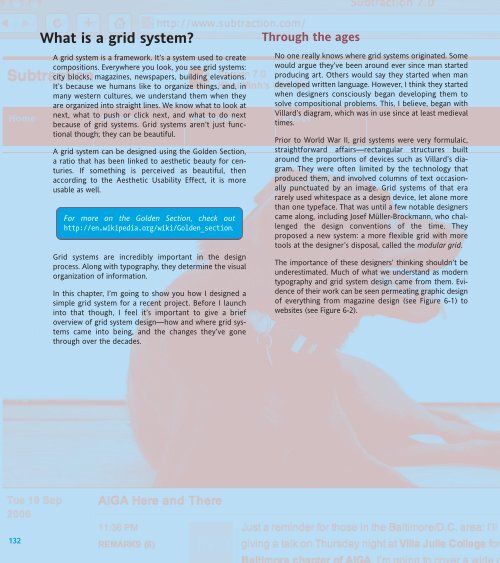WEB STANDARDS CREATIVITY
WEB STANDARDS CREATIVITY
WEB STANDARDS CREATIVITY
Create successful ePaper yourself
Turn your PDF publications into a flip-book with our unique Google optimized e-Paper software.
132<br />
What is a grid system?<br />
A grid system is a framework. It’s a system used to create<br />
compositions. Everywhere you look, you see grid systems:<br />
city blocks, magazines, newspapers, building elevations.<br />
It’s because we humans like to organize things, and, in<br />
many western cultures, we understand them when they<br />
are organized into straight lines. We know what to look at<br />
next, what to push or click next, and what to do next<br />
because of grid systems. Grid systems aren’t just functional<br />
though; they can be beautiful.<br />
A grid system can be designed using the Golden Section,<br />
a ratio that has been linked to aesthetic beauty for centuries.<br />
If something is perceived as beautiful, then<br />
according to the Aesthetic Usability Effect, it is more<br />
usable as well.<br />
For more on the Golden Section, check out<br />
http://en.wikipedia.org/wiki/Golden_section.<br />
Grid systems are incredibly important in the design<br />
process. Along with typography, they determine the visual<br />
organization of information.<br />
In this chapter, I’m going to show you how I designed a<br />
simple grid system for a recent project. Before I launch<br />
into that though, I feel it’s important to give a brief<br />
overview of grid system design—how and where grid systems<br />
came into being, and the changes they’ve gone<br />
through over the decades.<br />
Through the ages<br />
No one really knows where grid systems originated. Some<br />
would argue they’ve been around ever since man started<br />
producing art. Others would say they started when man<br />
developed written language. However, I think they started<br />
when designers consciously began developing them to<br />
solve compositional problems. This, I believe, began with<br />
Villard’s diagram, which was in use since at least medieval<br />
times.<br />
Prior to World War II, grid systems were very formulaic,<br />
straightforward affairs—rectangular structures built<br />
around the proportions of devices such as Villard’s diagram.<br />
They were often limited by the technology that<br />
produced them, and involved columns of text occasionally<br />
punctuated by an image. Grid systems of that era<br />
rarely used whitespace as a design device, let alone more<br />
than one typeface. That was until a few notable designers<br />
came along, including Josef Müller-Brockmann, who challenged<br />
the design conventions of the time. They<br />
proposed a new system: a more flexible grid with more<br />
tools at the designer’s disposal, called the modular grid.<br />
The importance of these designers’ thinking shouldn’t be<br />
underestimated. Much of what we understand as modern<br />
typography and grid system design came from them. Evidence<br />
of their work can be seen permeating graphic design<br />
of everything from magazine design (see Figure 6-1) to<br />
websites (see Figure 6-2).















